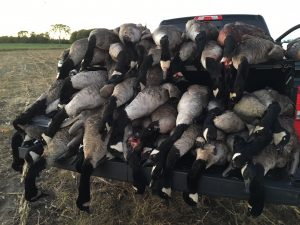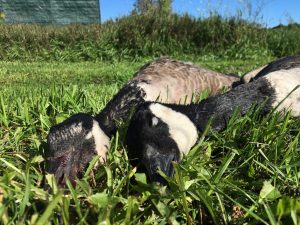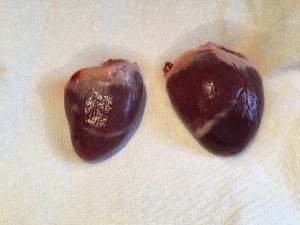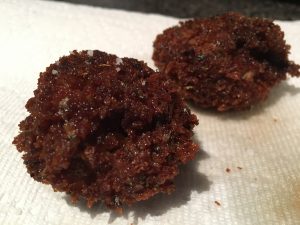I just about go crazy when I read bad press about Canada geese as table fare. We’ve posted a recipe earlier for a simple way to use early-season goose breasts, and we’re back with a great way to take care of those tasty, overlooked goose legs. Butchering the legs off a goose could not be easier: After opening up the bird to take the breasts out, just keep peeling back the skin off the legs all the way down the scaly black skin on the feet. Then push the legs backwards against the ball joints until they pop out. Then using a sharp knife cut around the ball joint and get the thighs and drumsticks to pull out. Lastly, cut the foot off at the knee joint or, alternately use some heavy snips to simply cut through the leg bone and remove the feet.
Once you have the legs they can be roasted, braised, or grilled. Our preferred method though is in a slow cooker, where the meat literally falls off the bone and can then be shredded and used much the same as pulled pork.
Oftentimes the legs get left behind because people fear they’ll be tough and sinewy, or they just get added to a grind pile. Although wild turkey legs can be rugged and almost no amount of cooking will thoroughly break down the thick tendons on those big birds, a long time in the slow cooker for goose legs breaks down almost all off the connective tissue, and you are left with tender, moist meat with almost no connective tissue to pick through.
I had a batch of this meat prepared recently and was really craving it one weekend morning. The kids wanted crepes, so once they had their breakfast out of the way, I added some cayenne pepper and garlic to the leftover batter and made a “grown-up” crepe that I then added some pan-crisped goose leg meat to. It’s now my go-to wild game breakfast (with sincere apologies to the goose camp staple McHonker breakfast sandwich, which I also still love).
Slow Cooker Goose Legs
Ingredients
- 1tbsp olive oil
- 4 goose legs
- Salt & pepper to taste
- 6 cloves garlic, crushed
- 1 whole lemon, cut into thin wedges
- 1 litre of reduced salt chicken broth
- 1/4 cup rye whiskey
- 4 bay leaves
- Sear the goose legs in a hot pan with the olive oil until brown on all sides. Add the oil and goose legs to your slow cooker and cover with all of the other ingredients.
- Ensure the legs are completely immersed in the broth. If the litre of chicken broth does not cover the legs completely add more broth or top it up with hot water.
- Put your slow cooker on it’s “longest” setting (mine is 10 hours) and let the whole batch simmer away. Check occasionally and top up the broth if needed to ensure the legs stay immersed in liquid.
- Once the time is up, remove the legs to a board and pull all the meat from the bones. I like to use two forks to pull and shred the meat, just as I would a smoked pork shoulder.
- This will keep for up to two weeks in the fridge or can be frozen and defrosted for future meals.
Spicy Garlic Crepes
Ingredients
- 1 cup all purpose flour
- 2 large eggs
- 1 cup skim milk
- ¼ tsp kosher salt
- ½ tsp cayenne pepper
- ½ tsp garlic powder
- Chopped parsley to garnish
- Mix the flour, milk, eggs, salt, cayenne, and garlic powder in a bowl and whisk together until smooth.
- Turn the burner to medium heat under a non-stick pan. If there are concerns about the batter sticking, a thin coating of cooking spray will help.
- Pour ¼ to ½ cup of the batter to the pan once it is heated and spin the pan to make a thin, round crepe. Cook until golden brown.
- Once the crepe sets, flip it over with a spatula and brown the other side.
- Set aside in a warm oven and repeat until all the batter is used (makes 4-6 crepes)
Assembling the dish is easy. I take a big scoop of the shredded goose legs and add it to the non-stick pan that I made the crepes in and I cook the leg meat over medium heat until it browns and gets crisp. I added a small amount of olive oil to speed this along. Then I simply put it on top of a crepe, sprinkled the plate with some parsley and then added the condiment of my choice. I experimented with standard BBQ sauce, as well as some home made Alabama white sauce. Both played nicely.
This whole process is admittedly a bit of effort to put together (even though the slow cooker does most of the work), but it is completely worth it. It makes a great dinner on its own, but also stands in as a superb hangover breakfast (just trust me okay?) and when served with a Bloody Caesar, it will cure pretty much anything that ails you.




